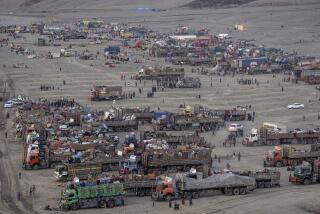Nighttime Is the Wrong Time in Afghanistan’s Capital
- Share via
KABUL, Afghanistan — The setting sun casts ribbons of orange, red and purple along the horizon, producing a brilliant backdrop for the Muslim calls to prayer echoing from Kabul’s mosques.
But when darkness falls over Afghanistan’s battered capital, the streets fall prey to thieves, gunmen and packs of wild dogs, and fewer and fewer worshipers are attending the day’s last prayers.
The walk home after dark is just too dangerous, said Imam Abdul Aziz, an elderly prayer leader at the historic Blue Mosque.
“There are too many guns in the city,” Aziz said.
There also are too many desperate people.
One recent evening, two young boys, each about 12, stood guard at a roadblock in Kabul’s southwestern Karte Se district. An orange glow from a small fire lit their faces.
When a reporter approached, one scampered off, his muddy sandals flapping against his feet. In a moment he was back, lugging a machine gun. Ten dollars bought passage through the unofficial checkpoint.
For almost two decades, Afghan children have been exposed to a culture of guns and violence--in the long rebellion against a Soviet-backed leftist regime and then in the civil war among the groups that ousted the Marxists. So it is not surprising that’s what they turn to for work.
It is not just children. With little of a functioning economy left and few jobs to go around, crime has become a way of life for many former guerrillas.
Theft and extortion aren’t the only crimes.
The London-based human rights group Amnesty International said thousands of civilians have been kidnapped from Kabul and held for ransom by rebel factions or splinter militia groups.
In a war zone, it is impossible to accurately account for the civilian toll in crime. But in its latest report on Afghanistan, Amnesty International said civilians have more to fear than the relentless rocket attacks.
In Kabul, women and girls often are targeted by armed thugs.
“Women and girls are treated as spoils of war, being raped by armed guards or sold into prostitution,” the Amnesty report said. “Unarmed civilians suspected of belonging to a rival ethnic group are routinely beaten and otherwise ill-treated.”
Late last year, two foreign relief workers were sexually assaulted at gunpoint after they were followed while walking home after dark.
“We’ve had to develop a buddy system if we go after dark,” said Gareth Wardell, an official with the International Assistance Mission. “Nobody goes out alone, and everybody is expected to check in when they get home.”
In Karte Se, where fighting raged for months last year, the few remaining residents and street vendors scurry off the streets when dusk approaches.
The city has no electricity. The nearest working power station outside the capital is in rebel hands. Without lights, blackness envelops the city after sunset. Walking the streets after dark is like stumbling around blindfolded.
“You just can’t be caught out,” said Azam Ansary, a former university professor who spends much of his time scavenging for food and firewood.
“At night, you can’t see what’s ahead of you,” he said. “It’s just not worth the risk to go out.”
Those who do venture out may face a hostile checkpoint guard on one block and a pack of wild dogs on another.
The dogs, mangy and rabid, come to life at night.
“You can hear them yelping at night, and you know they’re out there,” said Peter Stocker, a relief worker and longtime resident of Kabul.
Blanketed by darkness, Kabul is a city of sounds at night: the crackle of gunfire, the occasional boom of an explosion, the howling of dogs.
More to Read
Sign up for Essential California
The most important California stories and recommendations in your inbox every morning.
You may occasionally receive promotional content from the Los Angeles Times.









